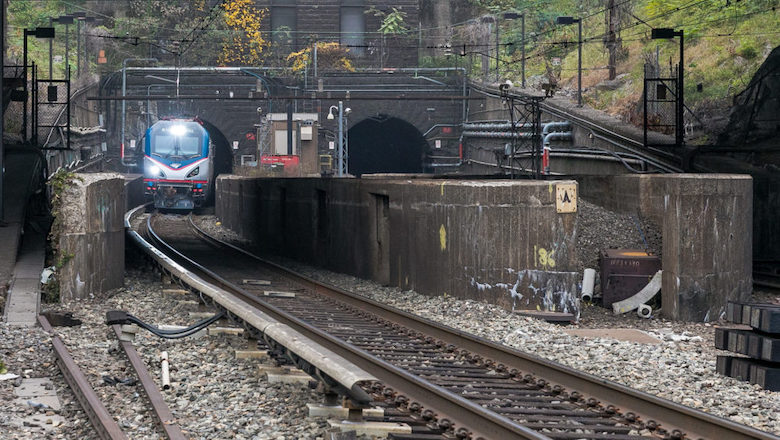President Joe Biden’s fiscal year 2023 budget request includes tens of billions of dollars for federal construction and infrastructure programs, supplementing the big gains provided in the Infrastructure Investment and Jobs Act.
But within the $5.85-trillion proposal, sent to Congress on March 28, some line-items would be increased from 2022 levels, such as new starts for transit, and others would be cut, such as U.S. Army Corps of Engineers' civil works.
The release of the budget is only the kickoff of what will be months of review and debate on Capitol Hill about fiscal 2023 spending. It would not be surprising for Congress to fail to approve the 12 individual appropriations bills by Oct. 1 when the new fiscal year begins.
In fact, the fiscal 2022 spending round was not wrapped up until March 15 of this year, more than five months after the current fiscal year began.
The new budget and appropriations season comes during a midterm election year, at a time when partisan fights will heat up. That could make a deal on fiscal 2023 spending even harder to achieve.
Charles Seville, Americas sovereign co-head for Fitch, a credit-rating firm, said in a statement that “many of the policy measures included in the budget remain unlikely to be passed.”
The reason, Seville said, is that that although the deficit and debt outlook has improved due to a fairly strong GDP growth over the past year, “in some respects … economic forecasts finalized in November and used as the basis for the budget (a longer lag than in the last two years) look too benign.”
Highway, Transit Proposals Track IIJA Levels
Steve Hall, American Council of Engineering Cos. senior vice president for advocacy, said in an interview, "Certainly, big picture, I think the administration is putting a lot more emphasis in this budget on programs to deal with the supply chain issues....and transit."
Hall adds, "It fully funds the IIJA programs, and in some cases even goes beyond that."
For construction programs, Biden's proposal shows mixed results. At the U.S. Dept. of Transportation, Deputy Secretary Polly Trottenberg said at a budget-day briefing that the $105-billion budget request “will allow DOT to address the long-standing maintenance and modernization needs of our most critical transportation assets..." [View USDOT FY 2023 budget summary book here.)
The infrastructure law's $37 billion for DOT would augment that spending. DOT has already allocated some of its 2023 money among the states, with more money to be released this year.
Within the $105-billion budget request, the key highway obligation ceiling would be set at $58.8 billion, the law's-authorized level, and a 2% increase over 2022.
Federal Transit Administration formula grants would edge up 1% in the budget, to $13.6 billion, the amount the IIJA authorized for 2023.
For the transit agency's Capital Improvement Grants, the Biden blueprint calls for a 27% hike from 2022, to $2.85 billion. The grants fund new transit starts.
In the briefing, FTA Administrator Nuria Fernandez highlighted a recommended $100-million CIG allotment for the New Jersey-New York Hudson Tunnels project, part of the multi-project Gateway Program of passenger rail improvements in the area. It would be the first federal funding for that portion of the $12-billion Gateway Program.
Fernandez noted that FTA was proposing the $100-million grant even though the agency and state and local officials had not yet signed a full-funding grant agreement. Such agreements are multi-year FTA funding pledges for projects. She said that the funding recommendation is “an affirmation [to project sponsors] that they’re on the right track.”
Corps of Engineers
Under the budget request, the Corps of Engineers civil works program discretionary funding would fall 20%, to $6.6 billion, including appropriations and allocations from the Harbor Maintenance and Inland Waterways Trust Funds. [view U.S. Army Corps of Engineers FY 2023 budget summary here.]
Of the $6.6 billion, $3 billion would go for commercial-navigation projects—such as river locks and dams—$1.5 billion would go for flood and damage reduction, and $624 million for aquatic ecosystem restoration.
Large allocations to individual projects include $172 million to complete the American River, Natomas Basin project near Sacramento, Calif., and $157 million to dredge the Corpus Christi Ship Channel and barge lanes in Texas.
Although some of the Corps' civil works accounts would decline from 2021 appropriations levels, Congress has had a history of rejecting proposals to cut the civil works budget from presidential administrations of both parties.
And the Corps has no dearth of work ahead, thanks in part to its share of the new infrastructure law. In January, the Corps announced projects on which it plans to spend more than $10 billion in fiscal 2022 IIJA funds.
But Maj. Gen. Scott Spellmon, the Corps commander and Army Chief of Engineers noted at a briefing that besides the regular civil works appropriations, the Corps has much work ahead in military construction and other missions.
Spellmon says, "I don’t know that the level of investment that the Corps has seen has ever been higher in its history.” He adds, “Our goal is to get these projects in the ground as soon as possible.”
GSA, VA Buildings
Among federal buildings programs, the General Services Administration's federal buildings construction and acquisition account would receive $408 million, up 36% from 2022. By far the largest item on the GSA list is $380 million to resume funding for the Dept. of Homeland Security campus at the St. Elizabeths site in Washington, D.C. [View GSA Federal Buildings Fund FY 2023 budget summary here.]
GSA's federal buildings repairs and alterations account would get $1.75 billion, including $115 million for the John J. Moakley federal courthouse in Boston.
At the Dept. of Veterans Affairs, the major-projects construction account would dip 10%, to $1.4 billion. Of that, the largest single allocation would be $550 million for a new health care center in El Paso, Texas. VA's major projects are those valued at more than $20 million.
[View VA's FY 2023 budget summary for construction, long-range capital plan here.]
EPA Water Infrastructure
But the U.S. Environmental Protection Agency Clean Water and Drinking Water State Revolving Funds, the primary federal funding mechanisms for wastewater and drinking water infrastructure projects, did not fare as well.
The infrastructure law authorized historic funding levels for the SRFs —$11.7 billion over the next five years for each—but the fiscal 2023 request is in line with the amount enacted in fiscal 2022 and in fiscal 2021.
The law included language that made clear that the amounts appropriated under the law were to be in addition to dollars from the annual budgetary process, says Kristina Surfus, the National Association of Clean Water Agencies managing director of government affairs. So, Surfus says, the fact that the 2023 budget request did not match the significantly higher amounts suggested in the IIJA is a “missed opportunity.”
She adds, "We want to make sure IIJA is in fact a supplement to continued growth in federal support for water investment. That means annual spending is increasing in line with what we saw authorized under IIJA.”
ACEC's Hall notes, "Sometimes past administrations will not give [the SRF category] the attention and support that it really needs, and Congress will go back and backfill."
He adds, "It remains to be seen whether it happens this time or Congress just keeps the numbers lined up with what's in the [IIJA] law."
In another EPA category, the funding request for Superfund cleanups was also down, to $1.15 billion for fiscal 2023 from $1.23 billion enacted for fiscal 2022, and well under the $3.5 billion invested under IIJA.
Clean Energy
The proposed budget provides a hefty increase for U.S. Dept. of Energy programs aimed at demonstrating the viability of various decarbonization and renewable technologies. Overall, the budget calls for $9.2 billion in DOE clean-energy research, development and demonstrations.
Much of that will go to DOE’s Advanced Research and Projects Agency-Energy (ARPA-E), and the Office of Clean Energy Demonstrations, created under the infrastructure law.
The budget request calls for $700 million for ARPA-E, a 56% increase over 2022. The administration is also requesting $112 million for clean-energy demonstration projects, $277 million for large-scale carbon-capture pilot projects, $114 million for regional clean-hydrogen hubs and $57 million for an energy storage demonstration pilot program.
The budget also includes $20 million for a new solar manufacturing accelerator program to help create a more robust domestic supply of equipment and materials to help meet the Biden administration’s solar deployment goals.
Lisa Jacobson, president of the Business Council for Sustainable Energy, said the coalition’s members are pleased with the budget proposal's boosts in clean-energy technologies and energy-efficiency programs. “If enacted, this budgetary signal, along with legislative proposals currently under consideration in Congress, would significantly accelerate the deployment of clean energy and energy efficiency solutions across the country,” Jacobson said.
Sheila Hollis, acting executive director of the U.S. Energy Association, noted that the energy sector is in the midst of a shift toward lower emissions, but that transformation needs sustained funding and successful project deployment to become a reality. “There has to be a commitment over the long haul to be able to achieve these things because the investment is so huge,” she said.
One industry source said that the federal budgets over the next few years will fill in where the IIJA left off, allocating additional funds each year based on the amounts outlined for authorization in the infrastructure law.
“This is just the beginning,” the source said, noting that momentum for large projects or programs like CCUS plants or hydrogen hubs will grow over time. “Things will not start to pick up definitively until you hit the end of year two, year three. That’s the lag time, and how long it takes for this kind of money for these big [projects] to really start to have an impact because so much planning is required.”
Funding for DOE defense environmental cleanups saw a modest uptick, from $6.7 billion enacted in the omnibus, to $6.91 billion for fiscal 2023.
Hall says of the budget's release, "It's the first step in a process. Now we've got to go through appropriations and fight that fight into the year." The goal is to avoid the drawn-out appropriations debate in 2021 and early 2022 that included multiple stopgap spending measures.
He says, "It'll be a challenge this year, obviously with it being an election year." But Hall says a full-year appropriations measure is "certainly doable before the end of the year if Congress chooses to clear the decks so the new Congress can start fresh."
Story updated on 3/29/2022 with ACEC comments, links to individual department and agency budget summary documents.]





